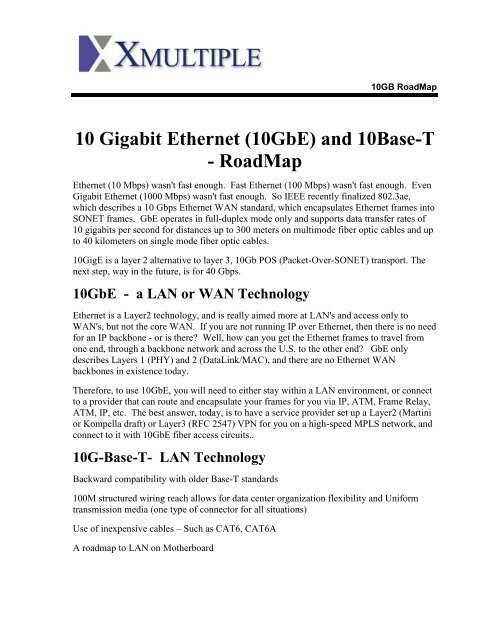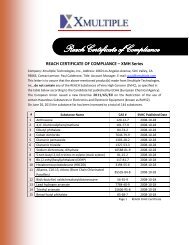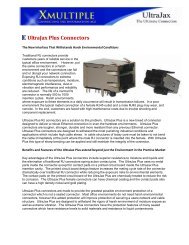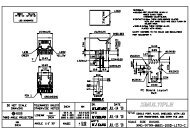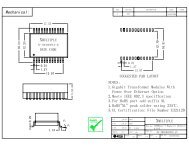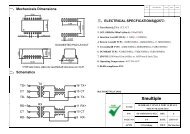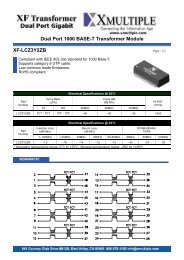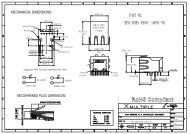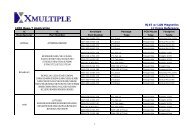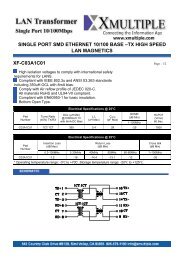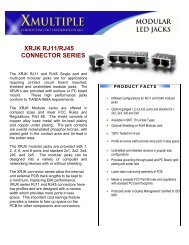You also want an ePaper? Increase the reach of your titles
YUMPU automatically turns print PDFs into web optimized ePapers that Google loves.
<strong>10GB</strong> <strong>RoadMap</strong><br />
10 Gigabit Ethernet (10GbE) and 10Base-T<br />
- <strong>RoadMap</strong><br />
Ethernet (10 Mbps) wasn't fast enough. Fast Ethernet (100 Mbps) wasn't fast enough. Even<br />
Gigabit Ethernet (1000 Mbps) wasn't fast enough. So IEEE recently finalized 802.3ae,<br />
which describes a 10 Gbps Ethernet WAN standard, which encapsulates Ethernet frames into<br />
SONET frames. GbE operates in full-duplex mode only and supports data transfer rates of<br />
10 gigabits per second for distances up to 300 meters on multimode fiber optic cables and up<br />
to 40 kilometers on single mode fiber optic cables.<br />
10GigE is a layer 2 alternative to layer 3, 10Gb POS (Packet-Over-SONET) transport. The<br />
next step, way in the future, is for 40 Gbps.<br />
10GbE - a LAN or WAN Technology<br />
Ethernet is a Layer2 technology, and is really aimed more at LAN's and access only to<br />
WAN's, but not the core WAN. If you are not running IP over Ethernet, then there is no need<br />
for an IP backbone - or is there Well, how can you get the Ethernet frames to travel from<br />
one end, through a backbone network and across the U.S. to the other end GbE only<br />
describes Layers 1 (PHY) and 2 (DataLink/MAC), and there are no Ethernet WAN<br />
backbones in existence today.<br />
Therefore, to use 10GbE, you will need to either stay within a LAN environment, or connect<br />
to a provider that can route and encapsulate your frames for you via IP, ATM, Frame Relay,<br />
ATM, IP, etc. The best answer, today, is to have a service provider set up a Layer2 (Martini<br />
or Kompella draft) or Layer3 (RFC 2547) VPN for you on a high-speed MPLS network, and<br />
connect to it with 10GbE fiber access circuits..<br />
10G-Base-T- LAN Technology<br />
Backward compatibility with older Base-T standards<br />
100M structured wiring reach allows for data center organization flexibility and Uniform<br />
transmission media (one type of connector for all situations)<br />
Use of inexpensive cables – Such as CAT6, CAT6A<br />
A roadmap to LAN on Motherboard
<strong>10GB</strong> <strong>RoadMap</strong><br />
Differences between standard and Fast Ethernet (10 and 100 Mbps) and<br />
10GbE<br />
<br />
<br />
For access, GigE requires fiber to the premises<br />
Since 10GbE is a full-duplex only and fiber-only technology, it does not need the<br />
carrier-sensing multiple-access with collision detection (CSMA/CD) protocol that<br />
defines slower, half-duplex Ethernet technologies. In every other respect, 10 Gigabit<br />
Ethernet remains true to the original Ethernet model.<br />
Differences between 1 GbE and 10GbE<br />
Comparison of 1 GbE to 10 GbE<br />
Characteristic 1 Gigabit Ethernet<br />
Physical Media<br />
Distance<br />
PMD<br />
PCS<br />
MAC Protocol<br />
Additions<br />
Optical and copper<br />
media<br />
LANs up to 5 km<br />
Leverages Fiber<br />
channel PMDs<br />
Re-uses 8B/10B coding<br />
Half-duplex<br />
(CSMA/CD)<br />
+ Full-duplex<br />
Carrier extension for<br />
Half-Duplex<br />
10 Gigabit Ethernet<br />
Optical media only<br />
LANs to 40km<br />
Direct attachment to<br />
SONET/SDH<br />
equipment for WANs<br />
Creates new optical<br />
PMDs<br />
Establishes new coding<br />
schemes<br />
Full-duplex Only<br />
Throttel MAC speed<br />
IEEE GbE Objectives<br />
The IEEE formed an HSSG (High Speed Study Group) which set out the following<br />
objectives for GigE:
<strong>10GB</strong> <strong>RoadMap</strong><br />
1) Preserve the 802.3/Ethernet frame format at the MAC Client service interface.<br />
• Meet 802 Functional Requirements, with the possible exception of Hamming Distance.<br />
• Preserve minimum and maximum FrameSize of current 802.3 Std.<br />
• Support full-duplex operation only.<br />
• Support star-wired local area networks using point-to-point links and structured cabling<br />
topologies.<br />
• Specify an optional Media Independent Interface (MII).<br />
• Support proposed standard P802.3ad (Link Aggregation)<br />
• Support a speed of 10.000 Gb/s at the MAC/PLS service interface<br />
2) Define two families of PHYs<br />
<br />
<br />
a LAN PHY, operating at a data rate of 10.000 Gb/s<br />
a WAN PHY, operating at a data rate compatible with the payload rate of OC-<br />
192c/SDH VC-4-64c<br />
3) Define a mechanism to adapt the MAC/PLS data rate to the data rate of the WAN<br />
PHY<br />
4) Provide Physical Layer specifications which support link distances of:<br />
<br />
<br />
<br />
<br />
<br />
at least 300 m over installed MMF (MultiMode Fiber)<br />
at least 65 m over MMF<br />
at least 2 km over SMF (SingleMode Fiber)<br />
at least 10 km over SMF<br />
at least 40 km over SMF<br />
5) Support fiber media selected from the second edition of ISO/IEC 11801 (802.3 to<br />
work with SC25/WG3 to develop appropriate specifications for any new fiber media).<br />
XGMII (X=10) 10 Gb Media Independent Interface<br />
Between the MAC and the PHY is the XGMII, or 10 Gigabit Media Independent Interface.<br />
The XGMII provides full duplex operation at a rate of 10 Gb/s between the MAC and PHY.<br />
Each direction is independent and contains a 32-bit data path, as well as clock and control<br />
signals. In total the interface is 74 bits wide.
<strong>10GB</strong> <strong>RoadMap</strong><br />
Ethernet is fundamentally a Layer 2 protocol. An Ethernet PHYsical layer device (PHY),<br />
which corresponds to Layer 1 of the OSI model, connects the media (optical or copper) to the<br />
MAC layer, which corresponds to OSI Layer 2.<br />
The 802.3ae specification defines two PHY types:<br />
LAN PHY - for native Ethernet applications. There are two types of LAN PHY:<br />
<br />
<br />
WWDM LAN PHY - uses a physical coding sublayer (PCS) based on four channels<br />
or lanes of 8B/10B coded data. Each lane operates at 2.5 Gb/s with a coded line rate<br />
of 3.125 Gb/s.<br />
Serial LAN PHY - initially it appeared attractive to reuse the 8B/10B code used with<br />
Gigabit Ethernet, however it was soon realized that the resulting 12.5 Gbaud would<br />
require costly technical issues to be solved and raise the development cost of effective<br />
serial implementation. It was therefore decided to employ a more efficient 64B/66B<br />
code, which reduced the serial baud rate to 10.3125 GBaud.
<strong>10GB</strong> <strong>RoadMap</strong><br />
WAN PHY - for connection to 10 Gb/s SONET/SDH - there is one type of WAN PHY:<br />
<br />
Serial WAN PHY - For this PHY an additional sub-layer known as the WAN<br />
Interface Sub-layer (WIS) is required between the PCS and the serial PMA. The<br />
position of this in the <strong>10GB</strong>ASE-W architecture is shown in Figure 1. The WIS maps<br />
the output of the serial PCS into a frame, based on SONET/SDH practice and vice<br />
versa, and processes the frame overhead including pointers and parity checks. The<br />
line rate is 9.95328 Gb/s.<br />
The WAN PHY has an extended feature set added onto the functions of a LAN PHY.<br />
Ethernet architecture further divides the PHY (Layer 1) into a Physical Media Dependent<br />
(PMD) and a Physical Coding Sublayer (PCS). The two types of PHYs are solely<br />
distinguished by the PCS.<br />
MDI (Media Dependent Interface) - the component of the media attachment unit (MAU)<br />
that provides the physical and electrical connection to the cabling medium. An MDIX (for<br />
MDI crossover) is a version of MDI that enables connection between like devices. MDI ports<br />
connect to MDIX ports via straight-through twisted pair cabling; both MDI-to-MDI and
<strong>10GB</strong> <strong>RoadMap</strong><br />
MDIX-to-MDIX connections use crossover twisted pair cabling.<br />
XAUI (X=10GbE) 10 GbE Attachment Unit Interface<br />
Pronounced “Zowie” - the XAUI is the 10GbE MDI. Remember the old AUI's that ancient<br />
Ethernet (over large coax, or "frozen garden hose") drops with their BNC connectors used<br />
Well, this is the same thing only faster. The XAUI is an interface extender, and the interface,<br />
which it extends, is the XGMII. The XGMII is a 74 signal wide interface (32-bit data paths<br />
for each of transmit and receive).<br />
The XAUI is not mandatory, because the XGMII can be used to directly attach the<br />
Ethernet MAC to its PHY. However, most applications want the extender for both<br />
physical workability, and for adaptation to Fiber Connectors.<br />
The XAUI may be used in place of, or to extend, the XGMII. The XAUI is a low pin count,<br />
self-clocked serial bus directly evolved from Gigabit Ethernet. The XAUI interface speed is<br />
2.5 times that used in Gigabit Ethernet. By arranging four serial lanes, the 4-bit XAUI<br />
interface supports the ten-times data throughput required by 10 Gigabit Ethernet. The XAUI<br />
employs the same robust 8B/10B transmission code of Gigabit Ethernet to provide a high<br />
level of signal integrity through the copper media typical of chip-to-chip printed circuit board<br />
traces. Additional benefits of XAUI technology include its inherently low EMI (Electro-<br />
Magnetic Interference) due to it’s self-clocked nature<br />
The XAUI is the actual physical interface for GbE, and has 70 pins. The XAUI is a full<br />
duplex interface that uses four (4) self-clocked serial differential links in each direction to<br />
achieve 10 Gb/s data throughput. Each serial link operates at 3.125 Gb/s to accommodate<br />
both data and the overhead associated with 8B/10B coding. The self-clocked nature<br />
eliminates skew concerns between clock and data, and extends the functional reach of the<br />
XGMII by approximately another 50 cm.<br />
Conversion between the XGMII and XAUI interfaces occurs at the XGXS (XAUI GbE<br />
Extender Sublayer).
<strong>10GB</strong> <strong>RoadMap</strong><br />
10 GbE Transponders (AUI to Fiber adapters)<br />
Like the original AUI's that required Transceivers to convert the AUI to RJ45 - you will need<br />
an additional adapter unit called a Transponder, to convert the XAUI interface to a standard<br />
fiber interface, such as an "SC" jack.<br />
There are varying numbers of pins on these - some have up to 200 or even 300 pins.<br />
But the most common is the 70-pin. For example, this transponder is sold by<br />
http://www.xenpak.org/ - Xenpak is defined specifically for 10-Gig Ethernet transponders<br />
and is connected through the IEEE XAUI interface. The transponder must therefore include<br />
the 64B/66B PCS block. The XAUI interface is a 4-channel, 3.125-Gbit/s interface with<br />
8B/10B encoding. XAUI extends the XGMII interface to 50cm and has a 70-pin, 2-row<br />
connector.
<strong>10GB</strong> <strong>RoadMap</strong><br />
Four wide XAUI interface (Lane 0,1,2, and 3)<br />
<br />
Compliant for all IEEE 802.3ae mediums<br />
o<br />
o<br />
o<br />
850 nm Serial<br />
1310 nm WWDM, 1310 nm Serial<br />
1550 nm Serial<br />
<br />
<br />
Hot Pluggable<br />
SC duplex fiber optic connector<br />
<br />
Industry standard 70 pin XAUI electrical connector<br />
10GbE Port Types<br />
The IEEE has defined a total of seven optical physical layers for 10-Gig Ethernet; these are<br />
shown in Table 1.<br />
Device Range Optics PCS WIS Fiber<br />
<strong>10GB</strong>ASE-LX4 300m MMF / 10km SMF 1310nm WWDM 8B/10B No<br />
<strong>10GB</strong>ASE-SR 300 m 850nm 64B/66B No Multimode<br />
<strong>10GB</strong>ASE-LR 10 km 1310nm 64B/66B No Singlemode<br />
<strong>10GB</strong>ASE-ER 40 km 1550nm 64B/66B No Singlemode<br />
<strong>10GB</strong>ASE-SW 300 m 850nm 64B/66B Yes Multimode<br />
<strong>10GB</strong>ASE-LW 10 km 1310nm 64B/66B Yes Singlemode<br />
<strong>10GB</strong>ASE-EW 40 km 1550nm 64B/66B Yes Singlemode<br />
Table 1: the seven IEEE 802.3ae Port Types<br />
Multimode or singlemode
<strong>10GB</strong> <strong>RoadMap</strong><br />
<strong>10GB</strong>ASE-LX4 - uses Wide Wavelength Division Multiplexing (also called coarse WDM).<br />
This is an inexpensive option for the enterprise that supports cheap multimode fiber for short<br />
distances and expensive single mode fiber for longer distances. This physical layer maintains<br />
the 8B/10B encoding for the Physical Coding Sublayer (PCS) from 1-Gig Ethernet. The<br />
resulting 13-Gbit/s data stream is split into four 3.125-Gbit/s signals and multiplexed onto the<br />
fiber through a 1310nm laser.<br />
<strong>10GB</strong>ASE-xR (Sr, LR, and ER) - designed for use in the enterprise and put a single 10-<br />
Gbit/s signal through the laser. These physical layers include a much more efficient 64B/66B<br />
encoding, resulting in a 10.3-Gbit/s data rate on the line. An 850nm laser with multimode<br />
fiber is defined for short distances, and 1310nm or 1550nm lasers with singlemode fiber are<br />
defined for longer distances.<br />
<strong>10GB</strong>ASE-xW (SW, LW, EW) - designed for use in the WAN and require the same line<br />
rate as Sonet. These physical layers use the same 64B/66B encoding, with a WAN Interface<br />
Sublayer (WIS) that is basically a cut-down Sonet framer. This sublayer packs the Ethernet<br />
packets into Sonet frames for transmission over a Sonet network. Again, three laser<br />
wavelengths are supported for different distances.<br />
The 10-Gig Ethernet distances are defined as 300m for short reach, 10km for long reach, and<br />
40km for extended reach. One issue starting to emerge is that as laser technology is further<br />
developed, cheaper 1310nm lasers are able to drive distances defined for the more expensive<br />
1550nm transponders in the IEEE specifications.<br />
In a 10-Gig Ethernet system, the 10-Gig Media Access Controller (MAC) is connected<br />
through either the XGMII or its XAUI to the physical layer. This is illustrated in Figure 2.
<strong>10GB</strong> <strong>RoadMap</strong><br />
GbE - Gigabit Ethernet<br />
GbE is virtually the same as 10GbE except for that it can run over copper or fiber (10GbE is<br />
fiber only). The copper adapters are different, of course, than the optical connctors. Here we<br />
do not delve into GbE except to list some of the connectors used - in order to differentiate<br />
them with the 10GbE XAUI and Transponder media connection interfaces.<br />
1000 Mbps (1 Gbps) SFP (Small Form-factor Pluggable)<br />
The SFP is similar to the 10 Gb transponder, except that it is used with copper, and is for<br />
GbE (not 10 GbE). Some SFP's will also auto-sense and can therefore be used for Ethernet<br />
(10 M), Fast Ethernet (100 M), and Gig Ethernet (1000 Mbps = 1 Gbps). Here is an example<br />
of an SFP:<br />
<strong>Xmultiple</strong> offers three different models of Gigabit Copper SFPs to accommodate different<br />
types of applications. The SFP-GC model supports Gigabit Ethernet with a 1000Base-TX<br />
interface and is designed for Layer 0/1 network devices. The SFP-EFG module supports<br />
Ethernet, Fast Ethernet and Gigabit Ethernet via a speed and duplex auto-negotiating<br />
10/100/1000Base-TX interface. It is also designed for use in Layer 0/1 devices. The third<br />
model is the SFP-GA-R which is designed for ruse in Layer 2 or above devices such as<br />
switches and routers. It supports GbE with 1000Base-TX interface. All three SFPs support<br />
MDI/MDI-X auto detect.
<strong>10GB</strong> <strong>RoadMap</strong><br />
GigE Connectors<br />
Copper SFC's - Small Form-factor Pluggable<br />
RJ-45 1 Gb GigE (1000base-T) (SFP-17)<br />
RJ-45 1 Gb GigE (1000base-T) (GBC-15)<br />
DB9 1 Gb GigE (1000base-CX) (GBC-10)<br />
HSSDC 1 Gb GigE (1000base-CX) (GBC-20)<br />
HSSDC2 GigE (1000base-CX)<br />
Optical GBIC's - GigaBit Interface Connectors<br />
SC Optical 1 Gb Single & Multi Mode<br />
1 Gb Multi Mode - Short-Wave GigE (1000base-SX)<br />
(GBC-30)<br />
1 Gb Single Mode - Long Wave GigE (1000base-LX)<br />
(GBC-31)<br />
LC Optical SFP Pluggable1 Gb Single & Multi Mode<br />
1 Gb Multi Mode - Short-Wave GigE (1000base-SX)<br />
(GBC-40)<br />
1 GB Single Mode - Long Wave GigE (1000base-LX)<br />
(GBC-41)<br />
LC Optical SFF Board-Mount 1 Gb Single & Multi<br />
Mode<br />
1 Gb Multi Mode - Short-Wave GigE (1000base-SX)<br />
(GBC-50)<br />
1 Gb Single Mode - Long Wave GigE (1000base-LX)<br />
(GBC-51)<br />
NOTE: the original 1 Gbps Ethernet was dubbed "Gigabit Ethernet". But with the<br />
advent of 10 Gbps Ethernet - many simply call it the same name - GigE and GbE. The<br />
official, correct term is "10GbE", but since the real GigE (1 Gbps Ethernet) is not very<br />
common, calling the 10 Gbps version, "GigE"


